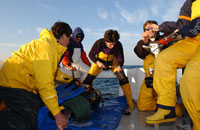The Tuna Research and Conservation Center team from Stanford University and the Monterey Bay Aquarium has just finished an 8-day trip aboard the Shogun in the California Current off Southern California and Baja California. Aboard we had staff from the Tuna Center (TRCC) and Tag-A- Giant Foundation, Ph.D students and undergraduate interns, and a post-doctoral fellow from Stanford University. I have fished with the superb Shogun Crew since 1994, and I don't recall the weather ever being so challenging on a single trip as it was this past week. For almost six straight days we had 15-25 knot winds, and this resulted in choppy seas and a rougher trip than we’re used to at this time of year. Captains Norm Kagawa and Bruce Smith worked hard searching for the bluefin we sought- despite utilizing all the tools of modern science- satellite imagery and even a spotter pilot we were unable during the rough weather period to locate a large school of bluefin tuna we were seeking for collection and tagging. We collect the fish live and transport the fish back to the TRCC for a variety of studies that includes understanding the energetics of bluefin tuna and specific studies focused on how the bluefin can tolerate the cooler waters. These sophisticated studies involve studying the cardiac dynamics (heart rate and beat to beat contraction) of the bluefin’s heart- the Lance Armstrong of the sea. In addition, we’re hoping to start some work on the Gulf Oil spill- where we plan to study how the bluefin tuna is affected by oil and dispersant mixtures. To this end we did collect some Pacific mackerels that will help to also examine some Gulf of Mexico Deepwater Horizon questions. We searched a wide area for the tunas and encountered a wide variety of sea conditions - colder at times (59-64F) than most seasons due to the ocean condition called La Nina- this is when a stronger than normal current south leads to upwelling.
Finally as a new week dawned the weather settled out- and we moved closer to traditional bluefin grounds we fish at this time of year offshore of Ensenada and within 8 hours of San Diego and sure enough we found a huge school of the small fish we were seeking- the good news is we did get some bites and finally put some fish in the wells. The fish were just the size we were looking for and we succeeded at sampling, collection and tagging. To help fill up wells for the collection trip- we stopped off on our way home at Baja Aquafarms- now one of the largest bluefin farms in the world. On a glorious sunny day- made even better by the week of bad weather- the owner and director helped the TRCC reach our scientific goals by allowing us to collect 2-3 year old fish to help complete a full load aboard the Shogun. We tagged some larger fish at the pens with archival tags- which was rather exciting as the fish were without question a bit frisky. This will allow studying the feeding cycles of the bluefin within the pen. The weather was gorgeous, and our day at the Coronados and the farm included some south of the island fishing making it a terrific day all around. We’re headed in to offload the fish- and get back to TRCC where we’ll begin a new year- training fish for our flume and studying the inner workings of Pacific bluefin- thanks again to the Shogun team.
Posted by Dr. Barbara A. Block
Below are some pictures- collecting bluefin and then one of my favorites- Captain Norm with his mackerel stretcher- you can always rely on Norm to keep us laughing.









